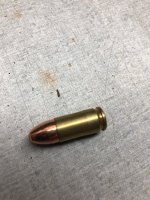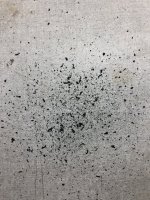New to reloading and I have loaded a bunch of 9mm 147grain with 3.4 gr of H Tightgroup, 1.15 oal, federal 100 small pistol primers getting an average of 1003 fps. Seem to be really accurate but leaving a mess in my suppressor, seems to be a lot of unburned powder. Any suggestions? Thanks
Join the Hide community
Get access to live stream, lessons, the post exchange, and chat with other snipers.
Register
Download Gravity Ballistics
Get help to accurately calculate and scope your sniper rifle using real shooting data.

Install the app
How to install the app on iOS
Follow along with the video below to see how to install our site as a web app on your home screen.
Note: This feature may not be available in some browsers.
You are using an out of date browser. It may not display this or other websites correctly.
You should upgrade or use an alternative browser.
You should upgrade or use an alternative browser.
Reloading 9mm problem?
- Thread starter Crankinsparky
- Start date
I've used Titegroup for a long time with 45 ACP (200 and 230 gr) (without a suppressor) it always just seemed to me a dirty powder when it came to carbon residue left on things. I think titegroup burns pretty fast but you might try reducing your load and switching to a magnum primer if you think you are having issues with unburnt powder - I found they increased my velocity and lowered me SD. Others here are more experience than me may have other insights.
Good luck!
-Chris
Good luck!
-Chris
It does appear to have carbon chunks or something in it also but I don’t know where it would be coming from, the suppressor is clean, gun is clean but after 1 magazine it is a lot of crap falling out of the suppressor. I have a ton of small rifle magnum primers, I’m guessing I can’t use those?
I could try that. Oh lord, what do you mean it’s a dangerous load? Thanks
You’re using the fastest burning powder to drive the heaviest bullet to max velocity. And then you add a suppressor which increases pressure. Your cases will fail. It’s a matter of time.
Oh wow, so I should back it down to 3 gr? What is optimum velocity?
I would back it down if it cycles your gun. But it would be better to use a slower burning powder like Bullseye 86 or AA#5 cuz in the summer when it’s hot you’ll blow primers and if you get any bullet setback during feeding your cases will rupture. TG blew up a lot of Glocks over the years. Be careful.
The can doesn't increase the chamber pressure. Cans increase back pressure, on gas-operated firearms, which is a completely different thing.
1003fps seems fast for that load though (based on: https://www.hodgdonreloading.com/reloading-data-center?rdc=true&type=53). Too much crimp maybe?
The crud is probably just crud, Titegroup is dirty stuff. Soot goes backward in a suppressed AR, with a handgun, much of it doesn't make it past the can.
Titegroup only blows up Glocks when idiots double-charge cases and then put them in Glocks.

1003fps seems fast for that load though (based on: https://www.hodgdonreloading.com/reloading-data-center?rdc=true&type=53). Too much crimp maybe?
The crud is probably just crud, Titegroup is dirty stuff. Soot goes backward in a suppressed AR, with a handgun, much of it doesn't make it past the can.
Titegroup only blows up Glocks when idiots double-charge cases and then put them in Glocks.

Last edited:
Ok, these days powders are hard to find and I have 2 jugs of tg. I guess I’ll try to back it down first and see what happens. What about without the suppressor on? I appreciate the info.
That’s where I got the load from, it says start 3.2 and max 3.6 so I figured 3.4 should be good. Maybe it is to much crimp but how do I tell how much crimp it’s getting or how much I need?
Ok, these days powders are hard to find and I have 2 jugs of tg. I guess I’ll try to back it down first and see what happens. What about without the suppressor on? I appreciate the info.
That’s where I got the load from, it says start 3.2 and max 3.6 so I figured 3.4 should be good. Maybe it is to much crimp but how do I tell how much crimp it’s getting or how much I need?
Shoot your load over a chrono with, and without, the suppressor. That should tell you everything you need to know (should be a little slower without the can... that might be where you're getting your extra speed, but check, don't guess).
Don't think of crimp as "crimp" with 9mm, a 9mm crimp die should actually be set up more like a "bell removal die"... just enough to drop into a case gauge or plunk in a chamber/barrel, no more.
Titegroup is a pretty fast burning powder. There is no way that what you're seeing is unburned powder that far away from the chamber.New to reloading and I have loaded a bunch of 9mm 147grain with 3.4 gr of H Tightgroup, 1.15 oal, federal 100 small pistol primers getting an average of 1003 fps. Seem to be really accurate but leaving a mess in my suppressor, seems to be a lot of unburned powder. Any suggestions? Thanks
Suppressors are dumb. Suppressors on pistols are double dumb.
Which bullet exactly are you using?New to reloading and I have loaded a bunch of 9mm 147grain with 3.4 gr of H Tightgroup, 1.15 oal, federal 100 small pistol primers getting an average of 1003 fps. Seem to be really accurate but leaving a mess in my suppressor, seems to be a lot of unburned powder. Any suggestions? Thanks
Secondly, exactly how and what are you using to capture velocity data?
I will try that tomorrow. So with less crimp the velocity will decrease?
Honestly, the can is the more likely culprit of where your extra speed is coming from. It may not be a problem, the soot may just be soot, and 1003fps isn't crazy or anything (but ~900fps would probably shoot just as well, while softer and not as hard on the gun).
That said, too much crimp can increase pressure/MV too in some cases, it's just something to look out for. Seems like most guys put more crimp on 9mm than is needed, usually it's not a huge deal, mostly guys cutting into bullet jackets and making shit ammo, but it can affect pressure/MV, so it's something to be aware of.
ETA: Be mindful if you back it down though... that's where Titegroup got its scary reputation from: USPSA guys would back down loads to a small enough charge where a double-charge would fit in a case and wouldn't spill over like a double 3+ grain charge normally would (making a mess and being obvious), and it would get by them... kaboom!
Last edited:
Here is a pic of the loaded Ammo and a pic of the crud from 20 rounds.
I don’t remember the brand of bullet and I am using a LabRadar for velocity
That round looks fine IMO (you probably could use even a little less crimp than that though, but not bad, I've seen WAY worse).
That carbon crud looks like... carbon crud.
You're probably just fine, chrono it with and without the can, but to me it just looks like: can (inherently dirty) + dirty powder = crud.
I will adjust the crimp on it and recheck velocity with and without the can. But damn, why so much carbon junk every clip full?
Just as an experiment a couple of things to try.Here is a pic of the loaded Ammo and a pic of the crud from 20 rounds.
I don’t remember the brand of bullet and I am using a LabRadar for velocity
Back off the crimp just a little bit. Also try seating a little bit deeper and see what happens.
And yes, that type of powder is dirty but far better than nothing.
Also, do you know if that bullet is a plated bullet or not? If it's plated instead of jacketed, that will solve the entire mystery about the extra velocity.Here is a pic of the loaded Ammo and a pic of the crud from 20 rounds.
I don’t remember the brand of bullet and I am using a LabRadar for velocity
But damn, why so much carbon junk every clip full?
You'll get less crud if you use magazines instead of clips.
Tightgroup is pretty dirty nasty stuff, and burns hot. Makes it easy to differentiate your brass from others, as it will turn it colors. I agree, that load sounds fast at a 146 power factor and you should double check your crono readings. I load and shoot a shit ton of 147s in my hot rod pistols using Vihtavuori N320 and FN FMJs ( Zero an RMR brands ) in a similar loading at 3.4 grains. The stuff is super clean. The 'Gamer' load recoil makes a hero out of even poor shooters such as I. Downside is the load just makes minor PF at 128, and can sometimes dip under. Check over at the Enos forums, good info on shooting the heavies there https://forums.brianenos.com/forum/72-9mm38-caliber/
If you would like to consider some other powders that are much cleaner burning here is a great resource to see what’s available to you that should help.
I think I was typing this when other replies were coming in, so it bears repeating if you didn't see it:
If you choose to back down your charge, be mindful... Titegroup got its scary reputation from: USPSA guys would back down loads to a small enough charge where a double-charge would fit in a case and wouldn't spill over like a double 3+ grain charge normally would (making a mess and being obvious), and it would get by them... kaboom!
Don't do that.
That's part of why most have moved to slower-burning powders like N320 and Sport Pistol, the case-fill level at lower power factors is like a built-in safety feature.
If you choose to back down your charge, be mindful... Titegroup got its scary reputation from: USPSA guys would back down loads to a small enough charge where a double-charge would fit in a case and wouldn't spill over like a double 3+ grain charge normally would (making a mess and being obvious), and it would get by them... kaboom!
Don't do that.
That's part of why most have moved to slower-burning powders like N320 and Sport Pistol, the case-fill level at lower power factors is like a built-in safety feature.
Where did you buy them from? Or take a bullet and a knife and try to scrape the projectile.I really don’t remember but I’m thinking they are plated
Mixing up load data between a jacketed bullet and a cast lead or plated bullet can be dangerous for sure.
If you don't know, you NEED to know. Like yesterday.
Vocabulary word of the day: obturation.
A pure lead bullet with no jacket or whatever, when you pull the trigger it will expand outward in the bore more as it is a lot more pliable. This in effect seals up the barrel trapping more of the hot gas.
A copper jacketed bullet has a harder shell around it and is a lot less pliable than pure lead. As a result it allows a certain amount of gas to 'blow by' so to speak during firing. In other words it has a lot less obturation.
A plated bullet is somewhere in between those two hence with plated bullets you have to back off the charge a bit to avoid dangerous situations. How much in between depends on a lot of things. A softer lead alloy will be much closer to the pure lead side. A harder lead will be a little closer to the jacketed side, but still it's NOT jacketed.
TLDR: A bullet is not just a bullet. What they are made of matters. A lot.
A pure lead bullet with no jacket or whatever, when you pull the trigger it will expand outward in the bore more as it is a lot more pliable. This in effect seals up the barrel trapping more of the hot gas.
A copper jacketed bullet has a harder shell around it and is a lot less pliable than pure lead. As a result it allows a certain amount of gas to 'blow by' so to speak during firing. In other words it has a lot less obturation.
A plated bullet is somewhere in between those two hence with plated bullets you have to back off the charge a bit to avoid dangerous situations. How much in between depends on a lot of things. A softer lead alloy will be much closer to the pure lead side. A harder lead will be a little closer to the jacketed side, but still it's NOT jacketed.
TLDR: A bullet is not just a bullet. What they are made of matters. A lot.
I will check that out. Pardon me for being dumb but How do you get the PF value?
bullet weight in grains X muzzle velocity in fps / 1000 = power factor (pf)
FWIW, for gun games like USPSA/IDPA, the average 9mm power factor is ~125-130pf.
Meh, it's hot but it's not that hot. I'd back it down a touch but just because it would sound better at 900fps. TG is pretty dirty and burns hot (as previously mentioned). It will vaporize lead into your silencer or brake if you use open base bullets.
Similar threads
- Replies
- 5
- Views
- 548
- Replies
- 19
- Views
- 1K



